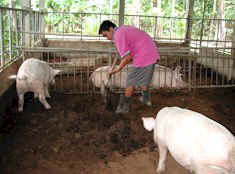YOU are familiar with a health drink that contains lactobacilli. That's supposed to help you digest your food more efficiently. Lactobacilli can also be used to raise healthy pigs which doesn't have the usually offensive smell of manure. And these pigs can be robust even without injecting them with veterinary drugs.
|
|
|
The lactobacilli keep the pig stay not foul-smelling because they destroy bad bacteria, the ones responsible for the bad smell. Actually, it's unnecessary to feed pigs with lactobacilli. Simply inoculates the "dirt floor" of the pigpen with the organism which keeps on multiplying. The pigs somehow imbibe the lactobacilli, too, and this improves their digestive system.
A typical pigpen is four meters by eight meter. It is roofed like any ordinary pigpen but instead of cement floor, the pigs live on a "dirt flooring" which is a big hole filled with shredded organic materials and 10% soil. The manure and urine of the pigs seep down and there's no need to clean with water like what other pig raisers do in their pigpens. The lactobacilli take charge in cleaning the pigpen. [Click here to learn this process.]
The moisture content of the dirt flooring should be maintained at 60 percent. This is because the good bacteria thrive and multiple best under such conditions. By doing that, just inoculates the pigpen with lactobacilli just once before putting the pigs inside the pen. There are usually wet spot in the pigpen like where the animals urinate. The moisture content in such spots can be adjusted by adding some dry soil. Aside from helping adjust the moisture content in the pigpen, the soil is also a source of necessary minerals for the nutrition of the pigs. Feed the pigs with ordinary hog rations but also gives them a lot of cut grasses which also provide the animals with vitamins.
But, where will you get the lactobacilli?
It is advisable to make your own. There are numerous species of lactobacilli and you can use those which you will get from the air of your place. Follow this procedure:
-
Boil 500 grams (half a kilo) of soybeans until the grains become very soft. While still very hot, blend it well and add one tablespoon of sugar. Take note that while the soybean is being blended, lactobacilli from the air will already get into it.
-
After blendering and while the soybean is still hot, put the material in a container that does not break from the heat. This could be a thick plastic container or glass jar that can take the heat.
-
Fill the container totally and seal it. The idea is to have no space at all for air to get inside. Under such anaerobic condition, only the lactobacilli will thrive.
-
Set aside the jar containing the blendered material under ordinary room temperature until it cools.
-
When it is already cool, put the same inside the refrigerator for one week. After that period the liquid and the solid portions would have separated. The liquid will be at the bottom while the solids will be on top.
-
The liquid at the bottom of the blendered material is the seed of the lactobacilli.
-
Strained it through a cheesecloth to harvest the lactobacilli.
-
To multiply this, put one liter of the lactobacilli in three liters of fresh milk (skim milk will also do), and put in plastic containers such as Tupperware and seal. Let this stand under ordinary room temperature for 4 to 5 days.
-
After that, pass the material through a cheesecloth or "katsa" to strain it. The liquid obtained is almost pure lactobacilli.
You
can multiply the lactobacilli indefinitely by repeating the above
procedure. The lactobacilli can be inoculated into the "dirt
floor" of the pigpen by sprinkling. In a 15-litter sprinkler (rigader)
put 300 cc or 1.5cups of lactobacilli and sprinkle it thoroughly on the
pigpen floor. Always maintain a moisture content of
60 percent. To maintain a better acidity of the shredded pigpen
floor materials, add 0.3% salt and some lime.
Reference: "Japanese
Raises Pig With Lactobacilli" by Zac B. Sarian (Philippine Panorama Sunday Magazine of Manila Bulletin
- Sunday, February 13, 2000)
-
See some more pictures of the actual designs of my pigpens. Click here.
Click here to go back to the Main Page

